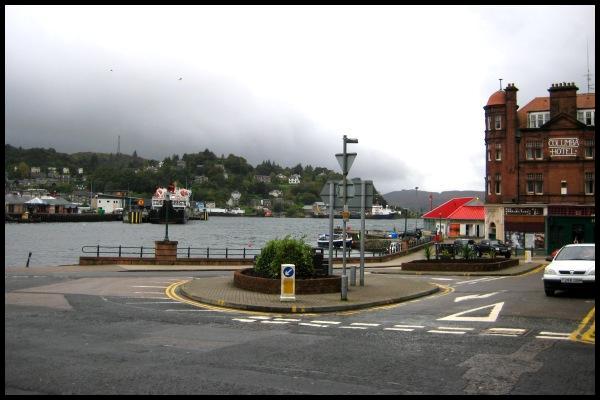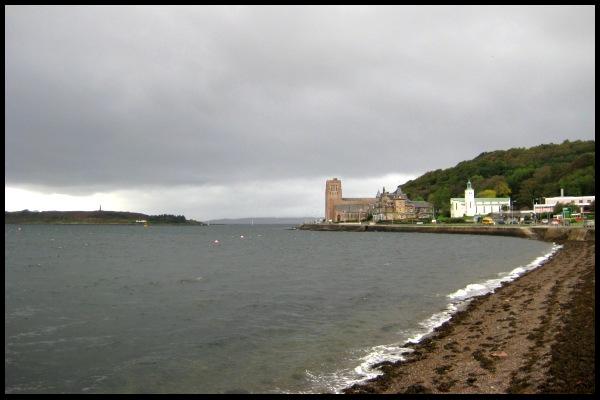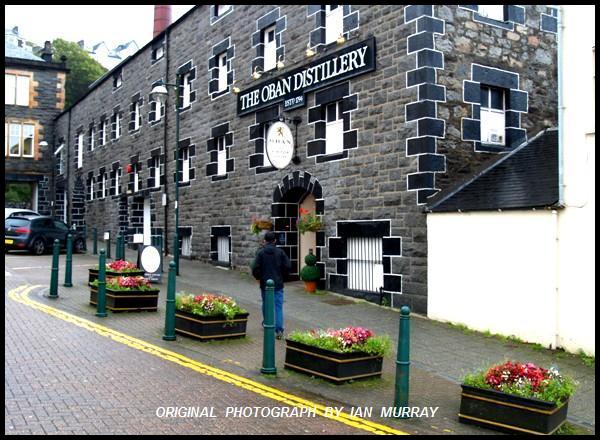A Rich Pour 27: Oban – An Ancient Place
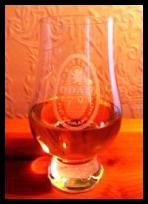
Monday January 19, 2015
Oban (which is Gaelic for “little bay of caves”) is an attractive western Scotland community boasting a degree of frenzied activity, and a number of places of interest, that belie its relatively modest population. The town, known as the Gateway to the Isles, also plays a prominent role as a ferry terminus owing to its central coastal location and naturally sheltered bay.
One feature that grabs just about every first-time visitor’s attention is a large, coliseum-like structure perched atop a hill overlooking the town. A Roman ruin, perhaps? Alas, not. Rather, a never completed edifice erected between 1897 and 1902 by wealthy banker John Stuart McCaig, and variously entitled McCaig’s Tower or McCaig’s Folly. So much for the illusion of blog.
More important for whisky lovers, though, is what stands on Stafford Street seventy odd feet beneath McCaig’s circular creation – namely Oban Distillery.
Five millennia have come and gone since humans first sought shelter along Oban’s craggy shoreline. Whisky making and the town of Oban itself are far more recent phenomena. Nevertheless, the area surrounding this coastal community boasts a fairly long history of illicit spirits distillation.
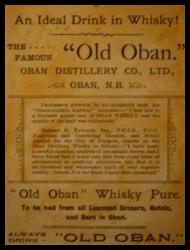
J. Walter Higgin acquired Oban Distillery in 1883, and enlarged the premises over the next four years, adding substantial warehousing space in the process. Most of the site’s present-day structures, with their attractive charcoal-grey stone facades, date from Higgin’s period of expansion. Alexander Edward, owner of the Aultmore Distillery in Speyside, purchased Oban from Higgin in 1898.
Over the course of the 20th-Century, Oban’s ownership followed the path of so many other Scottish malt whisky enterprises. The distillery became a subsidiary of John Dewar & Sons in 1923, passed to Distillers Company Limited in 1925, and eventually ended up in the hands of United Distillers and Vintners, part of the Diageo spirits empire. Closures at Oban were, thankfully, two and far between – 1931 until 1937 and 1969 to 1972.
A tour of the distillery wends from the warmth of the stainless steel mash tun through the pungent, yeast-imbued fragrance emitted by brew bubbling away within the European larch washbacks to the tiny yet tidy still-house. Visiting entourages often bring together individuals from around the globe. When I was last there, people from Scotland, Wales, England, Belgium, South Africa, the United States of America and Canada were present.
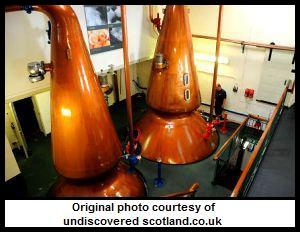 Oban Distillery draws its water supply from Lochs Gleann a’ Bhearraidh in the Ardconnel area of the peaty uplands a mile outside of town. Lightly peat-reeked malt (of the Troon variety of barley, when I inquired) has been brought in since 1968, when the on-site floor malting facilities were shut down. The still-site is very constricted, hemmed in as it is between a steep hill and storefronts facing the water. The distillery continues, despite major renovations carried out during the early 1970s and 1990s, to produce its malt whisky through a single pair of copper pot-stills. As Oban’s annual production of spirit is limited, its make is exclusively targeted toward malt whisky releases. (Even Chivas Brothers’ astounding Century of Malts, which comprised a melding of one hundred individual malts and was released during the mid-1990s, contained not one drop of Oban in the mix.)
Oban Distillery draws its water supply from Lochs Gleann a’ Bhearraidh in the Ardconnel area of the peaty uplands a mile outside of town. Lightly peat-reeked malt (of the Troon variety of barley, when I inquired) has been brought in since 1968, when the on-site floor malting facilities were shut down. The still-site is very constricted, hemmed in as it is between a steep hill and storefronts facing the water. The distillery continues, despite major renovations carried out during the early 1970s and 1990s, to produce its malt whisky through a single pair of copper pot-stills. As Oban’s annual production of spirit is limited, its make is exclusively targeted toward malt whisky releases. (Even Chivas Brothers’ astounding Century of Malts, which comprised a melding of one hundred individual malts and was released during the mid-1990s, contained not one drop of Oban in the mix.)
The distillery’s single malt was, for many years, aged primarily in well-used ex-Bourbon barrels. The match between coastal whisky and neutral wood worked well enough. Then, former manager Ian Williams sought to enhance the character of the malt by introducing 
Oban is a very charming place to visit in and of itself. And the fact that the town also boasts one of Scotland’s quaintest distilleries represents a true bonus for lovers of malt whisky. Furthermore, this locality offers a perfect point of departure for anyone wishing to venture to the outlying islands off the west coast.

Here are my tasting notes on a few malt whiskies produced at the Oban Distillery:
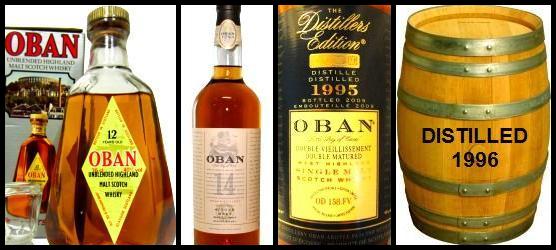
12 Year Old – 40% (discontinued)
14 Year Old – 43%
Distillers Edition – 43%
Cask Strength, distilled 1996 – Approximately 54%
Special official distillery editions of Oban, sometimes issued at cask strength and ranging anywhere from nine to thirty-two years of age, have periodically been made available in very limited quantities. These whiskies might be worth searching out provided your pockets are deep.
Slàinte!
Referenced articles and books
Doug Kuebler (jazznut) is an inveterate aficionado and collector of wines and whiskies. Apart from organizing wine and food seminars, Doug has also written extensively on wines and liquors over the last three decades. His first published book-set, The Tumbler's Guide to Single Malt Scotch Whisky, has been well-received in North America, the British Isles and Asia.



